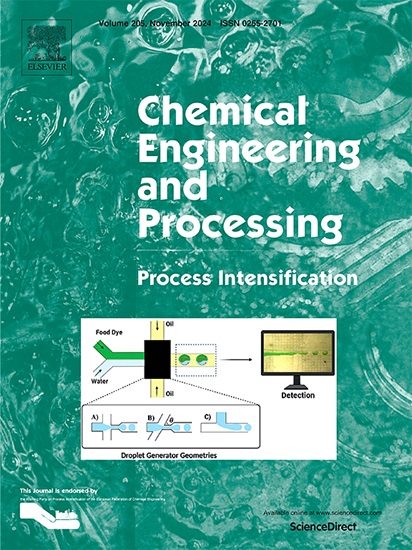Enhancing CO2 desorption in MEA solvent using low-frequency ultrasound: A flow-through reactor study
IF 3.8
3区 工程技术
Q3 ENERGY & FUELS
Chemical Engineering and Processing - Process Intensification
Pub Date : 2025-04-22
DOI:10.1016/j.cep.2025.110328
引用次数: 0
Abstract
This study explores the efficacy of ultrasound (US)-assisted CO2 desorption in a 30 wt. % monoethanolamine (MEA) solvent using a flow-through reactor. The tests demonstrated that the application of low-frequency (20 kHz) ultrasound accelerates the desorption process and reduces the desorption time required to release the same amount of CO2 for a given solvent compared to desorption by only heating the sample. This acceleration is attributed to the direct energy input into the solvent as well as the enhancement of heat and mass transfer caused by acoustic streaming and acoustic cavitation. The use of flow-through reactor systems suggests that the results can be scaled up to larger-scale processing. Notable improvements were observed at higher desorption temperatures, with sonication at 80 °C and above reducing CO2 loading in MEA below its thermodynamic equilibrium by 16 %. This allows CO2 release at 100 °C, compared to 120 °C with heating alone. The two-peak CO2 release pattern under sonication — initially from thermolysis and later from enhanced mass transfer — highlights the benefits of acoustic effects such as microstreams, vortices, and rectified diffusion. This method may also mitigate solvent degradation at high temperatures. Compared to conventional heating, applying sonication in a 30 wt. % MEA solvent consumes much less energy (172.65 kJ/mol CO2 compared to 343.85 kJ/mol CO2) to release the same amount of CO2 at similar desorption temperatures. This demonstrates that the application of low-frequency ultrasound can significantly decrease energy consumption during CO2 desorption. This method may result in decreased operational costs, provided affordable power is accessible for carbon capture facilities, especially via US-assisted desorption.

利用低频超声增强MEA溶剂中CO2的解吸:一种流动反应器研究
本研究探讨了超声波(US)辅助CO2解吸在30 wt. %的单乙醇胺(MEA)溶剂中使用流动反应器的效果。试验表明,与仅加热样品的解吸相比,低频(20 kHz)超声波的应用加速了解吸过程,并且减少了释放相同数量的CO2所需的解吸时间。这种加速归因于直接输入到溶剂中的能量以及由声流和声空化引起的传热传质增强。流动反应器系统的使用表明,结果可以扩大到更大规模的处理。在较高的解吸温度下观察到显著的改善,在80°C及以上的超声下,MEA中的CO2负荷降低了16%,低于热力学平衡。与单独加热120°C相比,这允许在100°C下释放二氧化碳。超声下的双峰CO2释放模式——最初来自热裂解,后来来自增强的传质——突出了微流、涡流和修正扩散等声学效应的好处。这种方法还可以减轻溶剂在高温下的降解。与传统加热相比,在30 wt. % MEA的溶剂中应用超声波在相似的解吸温度下释放相同数量的二氧化碳所需的能量要少得多(172.65 kJ/mol CO2与343.85 kJ/mol CO2相比)。说明低频超声的应用可以显著降低CO2解吸过程中的能耗。这种方法可能会降低运营成本,前提是碳捕获设施可以获得负担得起的电力,特别是通过美国的辅助解吸。
本文章由计算机程序翻译,如有差异,请以英文原文为准。
求助全文
约1分钟内获得全文
求助全文
来源期刊
CiteScore
7.80
自引率
9.30%
发文量
408
审稿时长
49 days
期刊介绍:
Chemical Engineering and Processing: Process Intensification is intended for practicing researchers in industry and academia, working in the field of Process Engineering and related to the subject of Process Intensification.Articles published in the Journal demonstrate how novel discoveries, developments and theories in the field of Process Engineering and in particular Process Intensification may be used for analysis and design of innovative equipment and processing methods with substantially improved sustainability, efficiency and environmental performance.

 求助内容:
求助内容: 应助结果提醒方式:
应助结果提醒方式:


